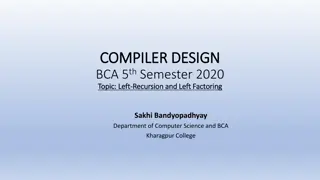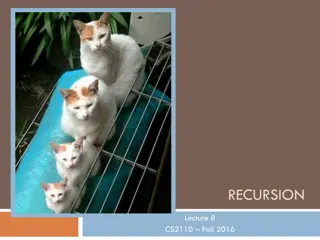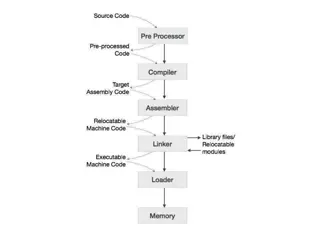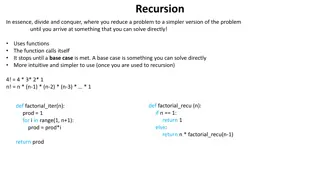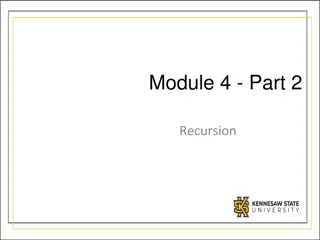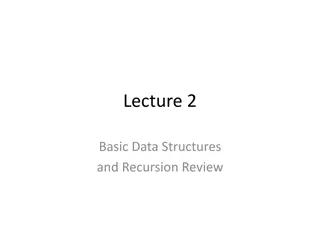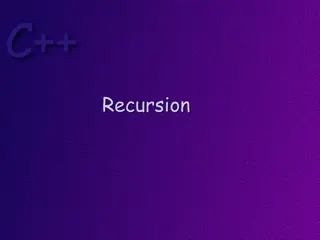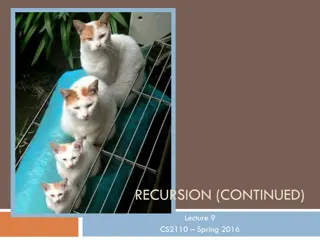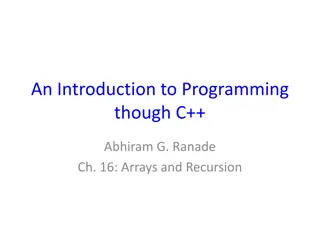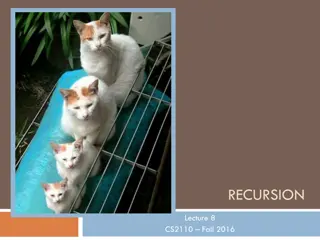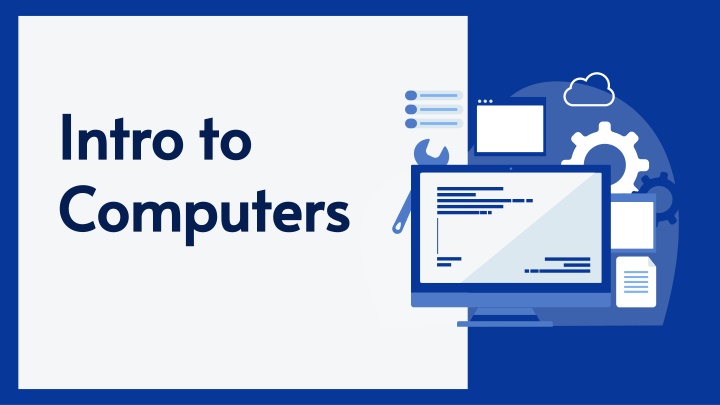
Key Components and Characteristics of Computers
Explore the essential components that make up a computer, including hardware, software, data processing, storage, input/output devices, networking capabilities, and programming. Discover how computers have become indispensable in various aspects of daily life.
Download Presentation

Please find below an Image/Link to download the presentation.
The content on the website is provided AS IS for your information and personal use only. It may not be sold, licensed, or shared on other websites without obtaining consent from the author. If you encounter any issues during the download, it is possible that the publisher has removed the file from their server.
You are allowed to download the files provided on this website for personal or commercial use, subject to the condition that they are used lawfully. All files are the property of their respective owners.
The content on the website is provided AS IS for your information and personal use only. It may not be sold, licensed, or shared on other websites without obtaining consent from the author.
E N D
Presentation Transcript
Intro to Intro to Computers Computers
A computer is a programmable electronic device designed to process, store, and retrieve data. What is What is Computer? Computer? It can perform a wide range of tasks and calculations, following a set of instructions called a program. Computers come in various sizes and forms, from personal laptops to servers and supercomputers. computers and
Here are some key components and characteristics of a computer: 1.Hardware: What is What is Computer? Computer? key components and characteristics This includes physical components like the Central Processing memory (RAM), storage devices (hard drives or SSDs),input devices (keyboard, mouse), output printer),and otherperipherals. 2.Software: Software refers to the set of instructions that tell the computer what tasks to perform. This systems (e.g., Windows, macOS, Linux), system software (e.g., device drivers), and application software (e.g., word processors,web browsers). Unit (CPU), devices (monitor, includes operating
Here are some key components and characteristics of a computer: 3.Data: What is What is Computer? Computer? key components and characteristics Computers process and store data, which can be in the form of text, numbers, images, videos, or any other type of information. Data is manipulated and transformed by the computer based on the instructions software. provided by 4.Processing: The CPU is the "brain" of the computer, responsible for executing instructions and performing calculations. Processing power is a key factor in determining a computer's performance.
Here are some key components and characteristics of a computer: 5. Storage: What is What is Computer? Computer? key components and characteristics Computers use storage devices to save data persistently. This can include hard drives, solid-state drives (SSDs), or other forms of storage media. 6. Input and Output: Input devices allow users to interact with the computer, providing data or commands. Output devices display the results or provide information to the user.
Here are some key components and characteristics of a computer: 7.Networking: Many computers networks, communicate and share information. This is crucial for tasks like accessing the internet, file communication betweendevices. 8.Programming: Computers can be programmed perform specific tasks. Programming involves creating sets of instructions (code)that thecomputercan execute. are connected them to to What is What is Computer? Computer? key components and characteristics allowing sharing, and to Computers have become an integral part of daily life, playing roles in various fields such as business, education, entertainment, research, and more. They continue to evolve in terms of capabilities, size, and functionality.
: Hi, I'm Chitti the Robot. Speed 1 terahertz, memory 1 zigabyte I continue to evolve in terms of Capabilities, Size, And Functionality..
WHAT IS A HARDWARE??? Hardware refers to the physical components of a computer system that can be touched and seen. These components work together to enable a computer to perform tasks and process data.
KEY HARDWARE COMPONENTS
Key Hardware Components Key Hardware Components 1. Central Processing Unit (CPU): Definition:The CPU is the "brain" of the computer, responsible for executing instructions and performing calculations. Example:Intel Core i5, AMD Ryzen 7. 2. Memory (RAM -Random Access Memory): Definition:RAM is temporary storage that the computer uses to store data that is actively being used or processed. Example:8GB DDR4 RAM. 3. Storage Devices: Definition:Storage devices store data persistently. Examples include Hard Disk Drives (HDD) and Solid-State Drives (SSD). 4. Motherboard: Definition:The motherboard is the main circuit board that connects and allows communication between all the hardware components. Example:ASUS Prime Z590-A.
Key Hardware Components Key Hardware Components 5. Graphics Processing Unit (GPU): Definition:The GPU is responsible for rendering graphics and is crucial for tasks like gaming and graphic design. Example:NVIDIA GeForce RTX 3070, AMD Radeon RX 6800. 6. Input Devices: Definition:Input devices allow users to interact with the computer. Examples include keyboards and mice. Example:Logitech MX Master 3 (mouse), Corsair K95 RGB Platinum XT (keyboard). 7. Output Devices: Definition:Output devices display information from the computer. Examples include monitors and printers. Example:Dell UltraSharp U2719D (monitor), HP LaserJet Pro M404dn (printer). 8. Networking Hardware: Definition:Networking hardware enables communication between computers in a network. Example:Router (e.g., TP-Link Archer C4000), Network Interface Card (NIC).
Key Hardware Components Key Hardware Components 9. Power Supply Unit (PSU): Definition:The PSU provides power to the computer components. Example:Corsair RM750x. 10. Cooling Systems: Definition:Cooling systems prevent components from overheating. Examples include fans and liquid cooling. Example:Noctua NH-D15 (air cooler), NZXT Kraken X63 (liquid cooler). These components work in harmony to create a functional computer system. The specific hardware configuration can vary based on the intended use of the computer, such as gaming, content creation, or general productivity.
WHAT IS A SOFTWARE??? Software refers to a set of instructions or programs that tell a computer how to perform specific tasks. It's the intangible part of a computer system that enables users to interact with hardware and accomplish various functions.
Categories of Software 1. Operating System (OS): Definition:The operating system is the core software that manages hardware resources and provides services for computer programs. Example:Windows, macOS, Linux, Android, iOS. 2. System Software: Definition:System software consists of programs that control and coordinate the hardware components of a computer system. Examples:Device drivers, utilities, antivirus software. 3. Application Software: Definition:Application software is designed for end-users to perform specific tasks. It enables users to accomplish things on the computer. Examples:Word processors (Microsoft Word), Spreadsheets (Microsoft Excel), Web Browsers (Google Chrome, Mozilla Firefox), Photo Editors (Adobe Photoshop).
Categories of Software 4. Utility Software: Definition:Utility software provides tools to perform maintenance tasks and improve system performance. Examples:Antivirus software, disk cleanup tools, backup software. 5. Programming Software: Definition:Programming software includes tools for writing, testing, and debugging software programs. Examples:Integrated Development Environments (IDEs) like Visual Studio, Eclipse. 6. Middleware: Definition:Middleware acts as a bridge between different software applications, allowing them to communicate and share data. Example:Java EE (Enterprise Edition), Microsoft .NET.
Roles of Software 1. Execution of Instructions: Software translates user instructions into machine-readable code that the computer's hardware can execute. 2. User Interface: Application software provides a user interface, enabling users to interact with the computer and perform specific tasks. 3. Data Management: Software handles the creation, storage, retrieval, and manipulation of data. 4. Resource Management: Operating systems and system software manage hardware resources, ensuring efficient utilization. 5. Security: Software, especially security applications, protects the system from viruses, malware, and unauthorized access. 6. Customization and Adaptability: Software allows users to customize their computing experience and adapt the system to their needs. 7. Innovation and Development: Programming software supports the creation of new applications, contributing to technological innovation.
Software Development Life Cycle: 1. Analysis: 2. Design: 3. Coding: 4. Testing: 5. Deployment: 6. Maintenance: Identifying requirements and planning the software. Creating a blueprint for the software's structure and functionality. Writing the actual code that the computer will execute. Verifying that the software behaves as expected and identifying and fixing bugs. Releasing the software for use. Providing ongoing support, updates, and improvements. Understanding software is crucial for users and developers alike, as it forms the bridge between human intent and machine execution in the world of computing.
Picture Picture abhi abhi baaki baaki hai hai .. ..


